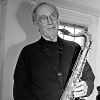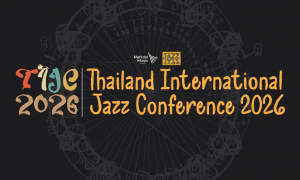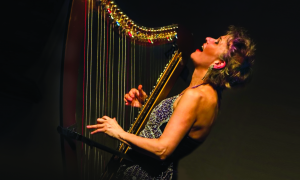
Hal's extraordinary sight-reading and performance skills on all reed and woodwind instruments landed him in the most challenging big bands and small groups of the period. His recordings as a leader between 1955 and 1958, often teamed with trumpeter Art Farmer [pictured], are marked by adventurous risk-taking and a dazzling outcome.
Over three days in late March and early April 1958, Hal recorded one of his most ambitious and fascinating albums: Cross Section--Saxes (Decca). What makes this album so compelling is its ambition and sound. Hal commissioned George Handy, Jimmy Giuffre, George Russell and Ernie Wilkins, four of the most dynamic arrangers of the day, to write charts for Hal's quintet, sextet and septet. Then Hal assembled the most skilled musicians of the day, including Art Farmer and Bill Evans, to record them.
This past Friday, I spoke with Hal about this important album:
JazzWax: What does the album's title mean?
Hal McKusick: It's a cross-section or variety of saxophone conceptions by leading arrangers. I think Marv Holtzman, the album's producer, came up with the title. He may have had a vision for other “cross section" albums with trumpets and trombones down the line but I don't think they were ever done.
JW: Which tells you something about your concept's stark challenges.
HM: I was leading a seven-piece working band in late 1957 and early 1958--four saxes with a rhythm section that included Bill Evans and Eddie Costa on piano, depending on who was available. The emphasis was on the voicings of those saxes and our collective sound.
JW: Who wrote the arrangements?
HM: Al Cohn [pictured] and Johnny Carisi. The arrangements were amazing. Unfortunately, I have no idea what happened to those charts and we never recorded them.
JW: Who was in your working band?
HM: Davey Schildkraut was on second alto, Dick Hafer was on tenor, and Gene Allen or Jay Cameron was on baritone.
JW: Where did the band play?
HM: We played for a few months at a club on Long Island, out by Levittown. The reception was great. There were always people in the club.
JW: When did you bring the concept to Decca?
HM: I had been recording for Coral, Decca's jazz subsidiary. I told Marv Holtzman about my group, and he said, “Great, let's do it."
JW: What was the next step?
HM: Commissioning arrangements for the concept I had in mind. I had known George Handy [pictured] for years, starting with Boyd Raeburn's band in the mid-1940s. I knew George Russell since the early 1950s, when we worked on his Lydian Chromatic Concept. Jimmy Giuffre I knew from my days on the West Coast in the mid-1940s and Buddy Rich's band in 1948. And Ernie Wilkins I knew from working with him on record dates in 1955 and 1956.
JW: How much guidance did you give the arrangers?
HM: Not much. I simply told them the songs I wanted and the instruments that would be featured. Then I told them to give me their best, most advanced thinking. I wanted their stamp on these songs, their approach, their particular sounds and flavor.
JW: That's an unusually respectful approach, not to mention risky, since you would have no idea what they would turn in.
HW: Each of these arrangers had a feel that I loved. I wanted to showcase their distinctions and not have all of the charts sound the same.
JW: It certainly helped that you and the musicians you chose had the ability to flawlessly play anything they came up with.
HM: I think that's why the arrangers had as much fun as they did with the charts. When the arrangements came in, the groups didn't have any trouble with them.
JW: Still, it's pretty tough to bring so much talent together and have the result sound so polished so quickly.
HM: Everyone I used I chose very carefully. All of them had been working steadily with me in the New York record studios. They knew exactly what to do and the flavor that was needed.
JW: Where was the album recorded?
HM: At Decca's Pythian Temple studios on West 70th Street off Broadway [pictured].
JW: You were close with Bill Evans before he became Bill Evans.
HM: We had known each other for years. We first recorded together in 1956 on George Russell's Jazz Workshop album for RCA and then the following year on the Brandeis Jazz Festival album.
JW: Was Cross Section--Saxes sort of a miniaturized version of Brandeis?
HM: No. I had already used this concept of bringing in leading arrangers like George Russell and giving them plenty of creative room while I was recording at RCA a few years earlier.
JW: What did Bill Evans think of your concept for the working septet?
HM: He loved it. Bill was interested in getting inside the music, to put his own touch on it while at the same time contributing to the whole. He always sought perfection. When you played a date with Bill or brought him in on a recording session, he would want to know exactly what was going to happen and what you needed from him. Then he would fit himself in appropriately. On Cross Section--Saxes, Bill looked over the charts carefully to see what they were all about. Then he determined his role. It was a fascinating process and outcome.
JW: This was Evans' last recording before he joined Miles Davis and recorded with him a month later. In some ways, it was Bill's unintended audition for that band.
HM: How so?
JW: According to Peter Pettinger's biography of Evans, Miles Davis asked George Russell for a pianist and Russell recommended Evans after working with him on Brandeis and Cross-Section--Saxes.
HM: Interesting. At this point Bill was so focused and deep into the music, what came out was always meaningful and fascinating. As a musician, there's so much there with Bill in terms of the complexity, simplicity and even humor.
JW: Did any rehearsing go into the three different Cross-Section--Saxes sessions?
HM: We ran down the charts once and then recorded them.
JW: Just like that?
HM: [Laughs] You have to remember that everyone there was at the top of his game. I chose the musicians because they were the best in the business from a technical standpoint and they also had individual personalities that came through on their playing.
JW: You didn't share your vision for pieces in advance with the arrangers?
HM: Telling arrangers at this level what to write would have been dumb. You have to frame what you want and then leave them alone. If you can do that, the result is almost always going to be exciting. And it was. [Pictured: George Russell]
JW: Did you tell the arrangers the keys you wanted for each song?
HM: I wanted everything to be in their original keys. This was out of respect for the songs and the composers.
JW: Was it always going to be a date with three different instrument configurations?
HM: Yes. I wanted a sense of adventure, to hear what these great arrangers would come up with for different size groups. These weren't favors, though. The arrangers were paid for the charts by the record company.
JW: Were the arrangements as tricky as they sounded?
HM: They took a lot. You had to have your reading head together. You had to be able to execute the charts with technical ability and blend together as a group and yet sound relaxed.
JW: There are some incredibly difficult passages.
HM: The double-time things were complicated but you had to play them with a relaxed attitude. You had to look over those parts before playing them. If there was a technical issue going on in a piece, we ran them down.
JW: On It Never Entered My Mind, did Giuffre throw in a bass clarinet part to up the ante?
HM: No. I played bass clarinet at the time and wanted a chart that included that sound.
JW: On Yesterdays, there are these odd tiny cymbals that play off the beat. Whose idea was that?
HM: Jimmy Giuffre called me while he was writing and said, “I have this idea. You know those little finger cymbals? I want to write those in." I said, “Great, do it." So we looked around and found a pair. If I recall correctly, Jimmy played them himself in the studio on the recording.
JW: How would you describe Giuffre's arranging style?
HM: With Jimmy, every note is carefully selected. Then he leaves spaces for you to blow. He created a special mood and approach for the quintet pieces. The group there featured me, Art Farmer, Bill Evans, Paul Chambers and Connie Kay.
JW: Clifford Brown's La Rue was arranged by George Handy.
HM: I wrote out that lead sheet and gave it to George. I just said, “Here, feature the saxes." For that date, I remember calling Charlie Persip but he wasn't available. I gave it some thought and realized that Connie Kay [pictured] had something special, a nice, wispy sound that was very musical and compositional. So I got him, and he was great.
JW: George Handy's Last Day of Fall also appeared on Zoot Sims Plays 4 Altos in 1957, which Handy arranged for Zoot.
HM: Zoot Plays 4 Altos had a big influence on me. I knew that by using Last Day of Fall on our date, George wouldn't have to work too hard to produce what I needed, since he had already written it for Zoot. He'd just have to revoice it for two altos, a tenor and baritone. The only thing I told him was, “Add that beautiful opening phrase that Zoot improvised," and George did.
JW: Was Handy a challenge to work with?
HM: Not at all. George [pictured] and I had a close working relationship that dated back about 15 years at that point. But with George, I'd always set a deadline ahead of time so I'd know the chart would come in with the parts copied and ready to go.
JW: You gave Now's the Time to Ernie Wilkins.
HM: I transcribed Charlie Parker's solo and asked Ernie for a chart. It wasn't the easiest task transcribing Bird's solo, as you can imagine. But the process was a great lesson for me in Bird's composition and ingenuity brilliance. Ernie's arrangement was terrific. Today, we think of Ernie and those big charts he wrote for Count Basie. Here, Ernie took Parker's blues and made it so delicate and light. Ernie could do it all.
JW: You also gave Wilkins Benny Golson's Whisper Not.
HM: I loved what Benny was writing then. He had such a melodic touch and his graceful style was in everything he wrote. Ernie [pictured] put his own gorgeous sound on top of Benny's melody. It's really something.
JW: Discographies show there have been 15 jazz recordings of George Russell's Stratusphunk. Yours was the first.
HM: I asked Jimmy, George Handy and George Russell for one original each. This was a period when the country was obsessed with outer space, and George loved the word “funk." George wrote the song and the arrangement for my sextet--me, Art Farmer, Barry Galbraith, Bill Evans, Milt Hinton and Charlie Persip. We loved playing George's things for that date. They were simpler pieces than much of his more far-out Lydian works.
JW: Which song on the album is your favorite?
HM: George Russell's [pictured] End of a Love Affair. I love the mood of it. The arrangement has this certain restlessness, too. It was a very East Coast sound, meaning you hear the energy and sophistication of the city--the close interaction of people, the hurrying, the ambition. That's how the musicians felt. Each of us was striving to break new ground. It was an exciting, experimental time for jazz, and that was reflected in the music.
JW: That East Coast, cosmopolitan sound is captured neatly on all of the album's pieces.
HM: True. You also can hear that the arrangers put their all into the things they wrote. Each one is a complete entity that expresses who that arranger was as an artist. On a session like this one, I was putting together a lot of puzzle pieces.
JW: Did you go into the album with an East Coast sound in mind?
HM: I'm not sure we were aware at the time of what we were doing. There may have been an undercurrent of awareness. I was just trying to create a balanced statement. In retrospect, I realize that the sound was a reflection of our lives in New York--the intensity, the art, the optimism all squeezed together.
JW: Were all of the arrangers at the recording sessions of their individual works?
HM: Yes. Arrangers should always be at their sessions in case the copyist has made a mistake or a change is needed. Each of the guys loved what they heard--the sound and the interpretation. They thought the musicians had paid enormous tribute to them.
JW: How would you sum up Cross Section--Saxes?
HM: It's a record with great musicians who had individual sounds. They all could read music brilliantly, listen carefully to each other, blend together and at the same time express their individuality. The arrangements gave us that opportunity. It's a gem of an album in that regard.
JazzWax tracks: Cross Section--Saxes is out of print and sells for ghastly sums. Much of the album is on Hal McKusick: Now's the Time, a compilation here (see lower-priced versions from independent sellers). Or search Google for downloads of Cross Section--Saxes.
Here's the album's personnel:
On the quintet: Art Farmer (tp), Hal McKusick (b-cl,as), Bill Evans (p), Paul Chambers (b) and Connie Kay (d).
On the sextet: Art Farmer (tp) Hal McKusick (cl,as), Bill Evans (p), Barry Galbraith (g), Milt Hinton (b) and Charlie Persip (d).
On the septet: Hal McKusick, Frank Socolow (as), Dick Hafer (ts), Jay Cameron (bar), Bill Evans (p), Paul Chambers (b) and Connie Kay (d).
JazzWax clip: Here's Hal McKusick a few years ago playing Home Town Blues with Don Friedman on piano, Jay Anderson on bass and Dennis Mackrel...
This story appears courtesy of JazzWax by Marc Myers.
Copyright © 2026. All rights reserved.























